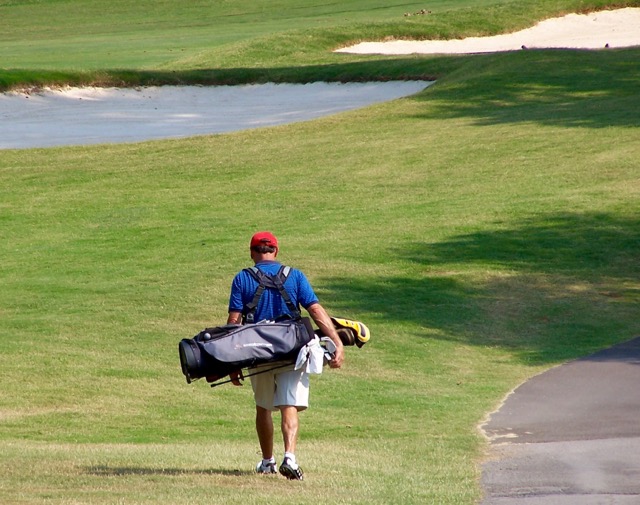by Anne Foy
There are many advantages to living in a golf community, and one of them is how much younger and full of energy you can feel when playing the sport. Most people think of running, going to the gym or cycling as a means of keeping fit, but golf also provides health benefits with less impact, making it an ideal form of exercise for the older person. It is gentle on the body and the chance of an injury is rare.
Walk Four Miles and Enjoy It
A Harvard Medical School study indicates that if a person walks a golf course for just one game, they will have walked as much as four miles or more. Walking 18 holes up to five times a week will give the heart an optimal amount of exercise and could help prevent heart disease. (If you can't make it to the golf course that many times, try to supplement with a cardio-healthy walk on a treadmill or around a local track.) Fox Den Country Club, near Knoxville, TN
Fox Den Country Club, near Knoxville, TN
Have Fun, Lose Weight
If a player carries his or her golf clubs or pulls them on a hand cart, this will give his heart an extra endurance test and should help him keep fit and lose weight, a better way to reduce BMI (Body Mass Index) than fad diets that typically do not work. Losing weight can relieve pressure on the joints, making that walk around the golf course even easier; reduce the chance of arthritis; and cut the risk of diabetes. The exercise aspect of a round of golf can also improve respiratory and vascular functions.
Forever Young (Looking)
Golf can help improve muscle tone and help players keep a better, more attractive shape. They might even have others thinking they look younger than they are. Improved muscle tone also means enhanced balance that, in turn, will reduce the chance of falls. Falls are the number one reason for visits to the Emergency Room by people aged 65 and over. And as anyone who plays golf regularly knows, balance is an integral part of the successful golf swing.
Glucosamine, without the Pills
The physical exercise of playing golf triggers the production of endorphins, the body’s natural pain reliever that is impressively 30 times stronger than morphine. (This will help ward off aches and pains and give a sense of wellbeing that protects against stress. Exercise also is fundamental to the production of glucosamine, a substance that is involved in lubricating the joints so that they glide smoothly. More glucosamine means more agility and less risk of arthritis when older.
You’ll Never Walk Alone…Unless You Want to
Getting involved in golf for the first time brings with it a new community and group of friends to expand a person’s social circle. Golf is a universally popular sport, played by more than 50 million people in 206 countries; therefore, there are always lots of different people to meet. A good social circle promotes good emotional health, and that can even increase life span. The University of North Carolina reviewed 148 studies of health outcomes and social relationships and found that people with few social connections had a 50% higher chance of dying during the study follow-up period of seven years, compared with people who had the most friendships. The difference was so extreme that some researchers have declared social isolation to be as damaging to health as cigarette smoking or other harmful addictions. Due to this and the physical and mental benefits of golf, including the possibility of longer lives, doctors are encouraging more people to take up golf. Cliffs at Keowee Vineyards, Sunset, SC
Cliffs at Keowee Vineyards, Sunset, SC
Off the Table and Onto the Course
Six million of the golfers in America are over the age of 50 and, with age comes health concerns. One of the most common ones is osteoarthritis, or ‘wear and tear’ arthritis of the joints. As the protective cushions between the joints wear out, bone can scrape on bone, causing pain and stiffness and reducing range of movement. Joint replacements are typically done in advanced cases. Of course, those golfers who must have a joint replacement always wonder how quickly they can resume playing the game, if at all. The good news is that golf is still good for people post-operatively. In a survey of the Hip Society, no surgeons prohibited their patients from playing golf and none reported any complications from resuming the game. Seven in 10 surgeons advised precautions such as using a cart while playing and waiting at least four months after surgery to resume golf, but with the proper guidelines more than 90% could enjoy the sport without any discomfort and still continue to enjoy all the recognized health benefits.
Anne Foy is a freelance writer and mother. She turned to writing as a more flexible career that complements parenthood. In her spare time she likes to follow sports and go for walks with her three standard poodles.



